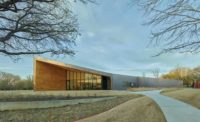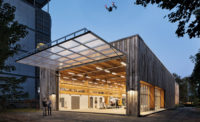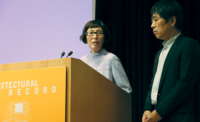Questions concerning how students learn do not automatically suggest design solutions, but when the Benchmark School approached William and Chris Sharples, two of the founding principals of SHoP Architects, for help in the development of robotics as a teaching tool, they saw opportunity.
Additional Content:
Jump to credits & specifications
The architects, identical twins and the “SH” in the firm’s name, are alumni of the independent school, founded in 1970, by Irene W. Gaskins, to help students who learn differently. In a recent phone conversation they finished each other’s rapid-fire sentences, such was their enthusiasm for the school that changed their lives. “We had graduated sixth grade, but our reading comprehension was barely at third-grade level,” said William. Their parents, aware how challenged their apparently bright sons were, enrolled them in the then-new institution. “We were very upset after the first day,” the Sharples said. “Two weeks later, we were having a ball.”
The two were ultimately diagnosed with dyslexia, which the school is geared to address, along with such diagnoses as perceptual difficulties and attention-deficit disorders—by first building confidence and then helping children discover their own ways of learning, an approach that has been influential. “We meet the students where they are, not where their age says they are supposed to be,” explained Betsy Cunicelli, Benchmark’s director of special projects.
Located in Media, Pennsylvania, 13 miles west of Philadelphia, Benchmark is a five-building, 23-acre campus serving 185 first- through eighth-grade students. There’s a heavy focus on reading and math, with instructors applying a wide range of learning research to support students individually in such tasks as time management, persistence, working collaboratively, and thinking critically.
Many dyslexics use visualization and hands-on experiences to commit concepts to memory. Students who struggle to comprehend a verbal explanation of something may understand better by assembling it on their own. This “constructing knowledge through experience,” as Benchmark puts it, is one way students learn.
Benchmark’s leaders and students visited both SHoP’s Manhattan office and the firm’s lab in an industrial space in Brooklyn, where they saw a repurposed auto–assembly line robot and tools for model-making, comparing fabrication possibilities, and mocking up assemblies to assess their constructability and visual impact. The school’s staff was impressed not only by the students’ excitement over the lab, but by the iterative problem-solving common in architecture. SHoP and the educators together concluded that an innovation lab could give students new opportunities to choose their own approach for addressing open-ended problems, while collaborating with others to succeed.
The resulting lab is a diminutive 2,200-square-foot glass-and-metal-clad two-story structure tucked like a hinge into a gap between two existing buildings. The full-height glass entry wall puts the Innovation Lab’s activities on display, engaging passing students. The upper level houses three spaces for middle-school pupils: two open labs separated by a sliding-glass partition for maximum flexibility, and a small triangular space (for messier projects) wedged between them behind a glazed wall. A classroom for the youngest children is on the lower level. With butcher-block lab-style tables, and counters along the walls for computers, the rooms include sinks, adjustable track lighting, powercord outlets that drop down from the ceiling, and whiteboard wall surfaces.

Photo courtesy SHoP Architects
Bowed wood strips suspended from the ceiling of the upper-level space demonstrate the assembly processes that students will use on their own; they were computer-designed and then CNC-milled in SHoP’s Brooklyn lab. Students learn how the ceiling was made by viewing the sequence of fabrication and assembly in a virtual-reality film; they can then apply a design-and-build process to their own work. Instructors also show off a similar design-to-fabrication process used for the exterior metal panels. The creases in the panels vary light reflections, designed according to a computer-generated algorithm.
The lab was completed in August 2018 but was fitted out over ensuing months. Pedagogically, it will remain a work in progress, with Benchmark director of innovation Emma Mattesky, who oversees the lab, helping instructors discover its possibilities. “We start with what we’re teaching already and use the lab as an enhancement, and technology as a tool,” said Mattesky. The techniques and materials can run the gamut from the quotidian to the specialized: spaghetti, glue, and Legos to computers, 3-D printers, and little model robots that can be assembled and coded by students to perform tasks like completing obstacle courses. “We’re thinking about how the lab reflects our teaching and practice strategies,” she adds.
“Visual art is lacking in a lot of curriculums and is not part of STEM programs,” said the Sharples. “For a learning-disabled student to say, ‘I can script [a computer program], I can build, and I can 3-D print’ gives them a big edge. This is what we hungered for back in sixth grade.”
Video courtesy Spirit of Space
CreditsArchitect: SHoP Architects, 233 Broadway, 11th Floor, New York, NY 10279, 212-889-9005
Personnel in architect's firm who should receive special credit: William Sharples AIA, Christopher Sharples AIA, John Cerone AIA LEED, Violette de la Selle, Geof Bell, Mike Budzinsky, Kendra Ho, Charlie Wynter, Aaron King, Carter Read
Architect of record: CICADA Architecture/Planning, Inc., 1520 Locust Street, Suite 702, Philadelphia, PA 19102, 215-247-1430
Engineers: MEP+FP: Bruce Brooks & Associates, 2209 Chestnut Street, Philadelphia, PA 19103, 212-569-0400 Structural: Orndorf & Associates, Inc., 8600 West Chester Pike, Suite 201, Upper Darby, PA 19083, 610-896-4500
Consultants: Owner’s Representative: Northstar Owner’s Representation Façade Manufacturer and Installer: Sobotec Lighting Design: Diversified Lighting Associates
General contractor: W.S. Cumby, Inc., 938 Lincoln Avenue, Springfield, PA 19064, 610-328-5353
Photographer: SHoP Architects |
SpecificationsExterior Cladding Metal panels: Sobotec Metal/glass curtain wall: Kawneer Rainscreen: Sobotec Moisture barrier: W.R. Meadows SealTight
Roofing Elastomeric: Firestone TPO Metal: Drexel Metals coping
Windows Metal frame: Kawneer
Glazing Glass: Alderfer Glass Other: Frameless glass partitions: Dormakaba
Doors Entrances: Kawneer Metal doors: Assa Abloy Sliding doors: Dormakaba
Hardware Locksets: Kawneer Closers: LCN Pulls: C.R. Lawrence
Interior Finishes Acoustical ceilings: CertainTeed Suspension grid: CertainTeed Cabinetwork and custom woodwork: Goebelwood Industries Inc. Paints and stains: Sherwin-Williams Plastic laminate: Wilsonart standard laminate Special surfacing: Epoxy Flooring: Sherwin-Williams general polymers Resilient flooring: Johnsonite ‘raised round’ rubber floor tile Special interior finishes unique to this project: Roller shades: WT Shade
Furnishings Chairs: Enea ‘Bio’ chairs Tables: Knoll ‘Pixel’ tables, Global Industrial ‘1210 series’ workbench Other furniture: Tolix ‘H’ stool, Artek ‘Aalto’ stool
Lighting Interior ambient lighting: Finelite Interior lighting: Pinnacle Architectural Lighting Under counter lighting: Bruck Lighting USA Tasklighting: Con-Tech Lighting Exterior: US Architectural Lighting Dimming system or other lighting controls: Hubbell Control Solutions
Plumbing Sink: Elkay Utility sink: Advance Tabco
Energy Add any additional building components or special equipment that made a significant contribution to this project: Mechanical: Perimeter fin tube radiators: Indeeco |









Post a comment to this article
Report Abusive Comment